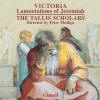Texte paru dans: / Appeared in:

Fanfare Magazine: 33:6 (07-08/2010)
Pour
s'abonner / Subscription information
Les abonnés à Fanfare Magazine ont accès aux archives du
magazine sur internet.
Subscribers to Fanfare Magazine have access to the archives of the magazine
on the net.
Gimell
CDGIM043

Code-barres / Barcode:
0755138104327 (ID31)
Consultez toutes les évaluations recensées pour ce cd
~~~~ Reach all the evaluations located for this CD
Polyphonic settings of the nine Lamentations that were sung in the first nocturn of Tenebrae, three each night, are included in Tomás Luis de Victoria’s greatest work, the Officium Majoris Hebdomadae of 1585, published as he was concluding his two decades in Rome. They were included in six comprehensive if not complete traversals of this monumental collection, summarized when the most recent issue appeared (Fanfare 29:2). While Victoria’s 18 Responsories, sung in the second and third nocturns, six each night, have additionally been recorded as a set fairly often, the Lamentations have appeared complete only under Raúl Mallavibarrena (21:1) and Harry Christophers (Collins 15182; Coro 16021). As it happens, Phillips (14:5) and Christophers (15:6) had also previously recorded the Responsories.
Phillips, like the notator for Christophers’ disc, makes some interesting points about the way Victoria expands the scoring of the Lamentations, adding voices in the third one each night and adding even more from the first night to the last. The concluding prayer of Jeremiah (the ninth of the series) attains a power of expression that must be heard. Both notes point out that in a couple of cases the concluding “Jerusalem” refrains are additionally set for a larger number of voices. Unlike Mallavibarrena and the complete collections, Christophers and Phillips record all of the duplicate settings. Phillips adds that Victoria set only the Lamentations for the first nocturn each night and only the responsories for the other two, probably because the service would be too long with any more polyphony. But he might have pointed out that Victoria also set only the first part of each Lamentation that was prescribed in the liturgical books (even the full chant settings preserve only part of the scriptural Book of Lamentations).
This helps to explain why the filler, a setting of the first Lamentation by Gutiérrez de Padilla, has three verses rather than Victoria’s two, still short of the five verses in the chant setting. This piece has been recorded by both James O’Donnell (14:3 and 34:4) and Harry Christophers (32:2), the latter in an all-Gutiérrez program. Phillips takes the piece faster than the other two, and it seems unfortunate that none of the three have gone beyond the first Lamentation of his complete set. Christophers and Mallavibarrena add several pieces to fill out their discs, but only an older LP set on Arion sensibly added the chant responsory to each Lamentation. All three of the single CDs are beautifully done, and I still like Christophers (now available on Coro), the most subdued of the three renditions. Mallavibarrena uses one voice to a part, while the others use two. Phillips’s is a very fine interpretation, and this will be a no-brainer for fans of the group.
Cliquez l'un ou l'autre
bouton pour découvrir bien d'autres critiques de CD
Click either button for many other reviews


